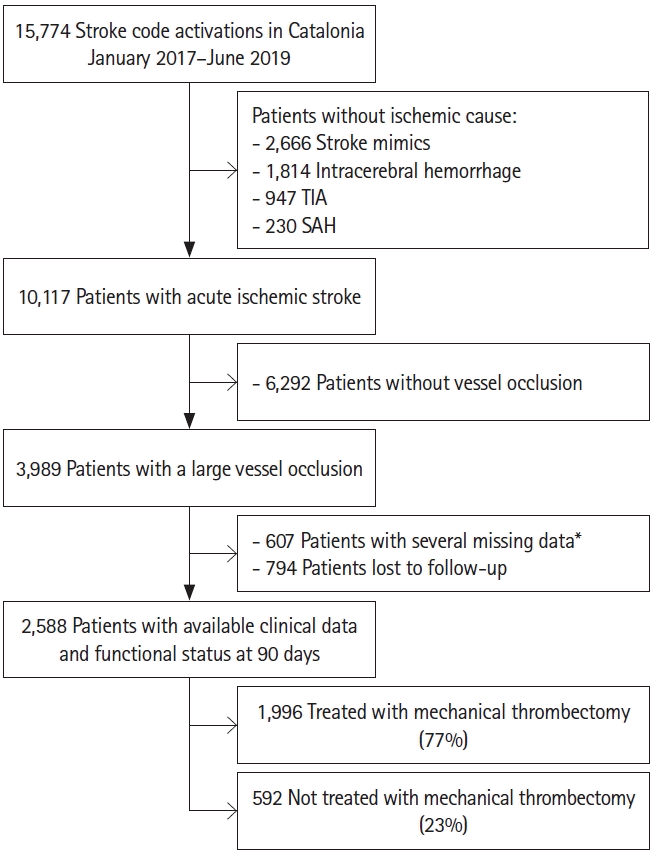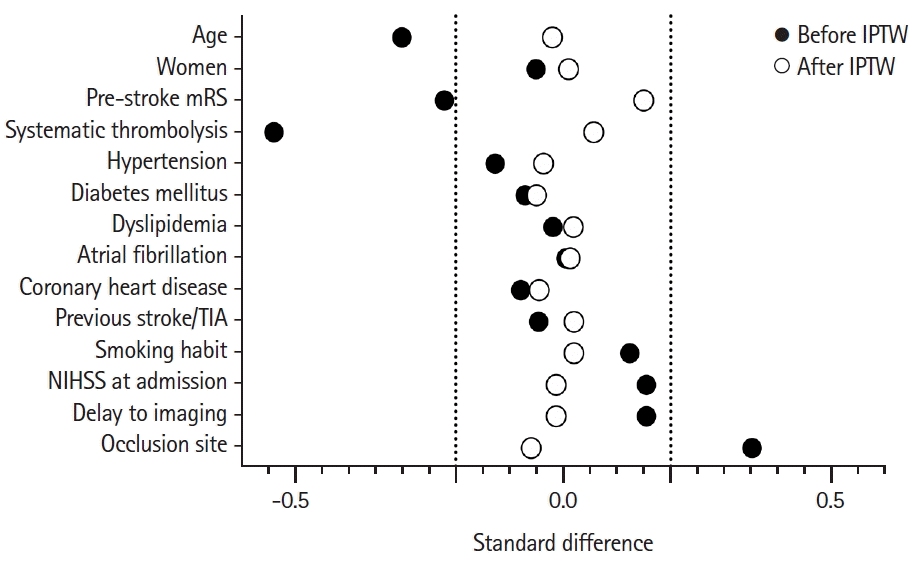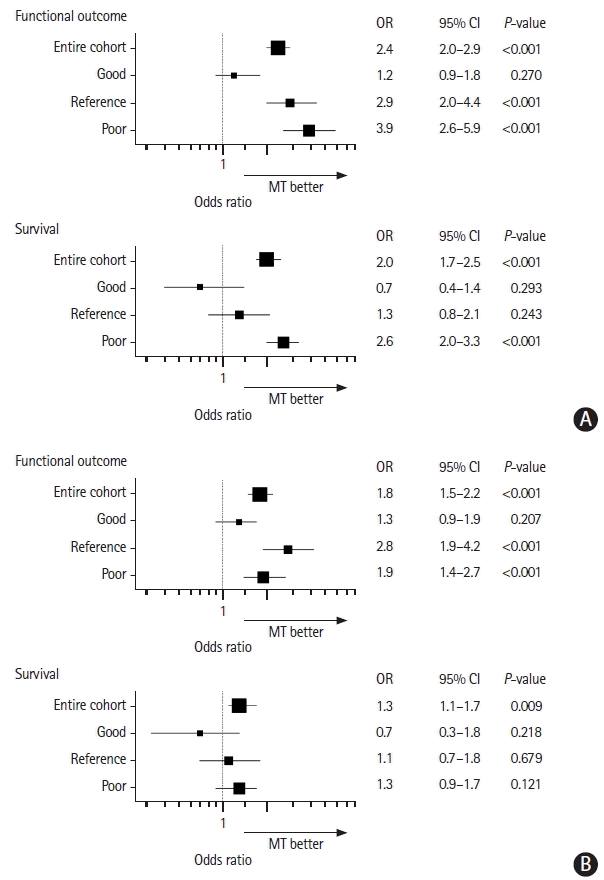Abstract
Background and Purpose
Methods
Results
Supplementary materials
Supplementary Table 1
Supplementary Table 2.
Supplementary Table 3.
Supplementary Table 4.
Notes
Catalan Stroke Code and Reperfusion (Cat-SCR) Consortium
Bellvitge, Hospitalet de Llobregat (Pere Cardona; Helena Quesada; Blanca Lara; Andrés Paipa; Ana Nuñez Guillen; Roger Barranco; Lucia Aja; Paloma Mora; Oscar Chirife; Sonia Aixut; Maria Angeles de Miquel; Toni Martínez-Yelamos). Vall d’Hebron, Barcelona (Carlos Molina; Marta Rubiera; Jorge Pagola; David Rodríguez-Luna; Sandra Boned; Marian Muchada; Alejandro Tomasello; Marc Ribó; Carlos Piñana; Manuel Requena; Matías Deck; Alvaro Garcia-Tornel; Marta Olivé; Noelia Rodriguez; Jesus Juega). Clínic, Barcelona (Ángel Chamorro; Sergio Amaro; Xabier Urra; Laura Llull; Arturo Renú; Salvatore Rudiloso; Juan M. Macho; Jordi Blasco; Luis San Roman Manzanera; Antonio López; Federico Zarco; Ramón Torné; Ricard Valero; Víctor Obach, Víctor Vera; Alejandro Rodriguez; Martha Vargas; Carlos Laredo). Germans Trias, Badalona (Mònica Millán; Natalia Pérez de la Ossa; Meritxell Gomis; Laura Dorado; María Hernández-Pérez; Anna Ramos; Alejandro Bustamante; Sebastiá Remollo; Carlos Castaño, Mariano Werner). Sant Pau, Barcelona (Joan Martí-Fàbregas; Raquel Delgado-Mederos; Alejandro Martínez-Domeño; Pol Camps-Renom; Luis Prats-Sánchez; Daniel Guisado-Alonso; Marina Guasch-Jiménez; Rebeca Marín Bueno; Jordi BraneraPujol; José Pablo Martínez, Lavinia Dinia). Joan XXIII, Tarragona (Anna Pellisé; Xavier Ustrell; Alan Flores; Laia Seró). Josep Trueta, Girona (Joaquín Serena; Yolanda Silva; Mikel Terceño; Saima Bashir; Víctor Vera; Alan Murillo). Mútua de Terrassa (Jerzy Krupinski; Sonia Huertas; Jessica Molina; Georgina Figueras; Sarah Besora). Mar, Barcelona (Ana RodríguezCampello; Jaume Roquer; Ángel Ois; Eva Giralt-Steinhauer; Elisa Cuadrado-Godia; Jordi Jiménez-Conde; Elio Vivas; Polo Guimaraens). Taulí, Sabadell (David Cánovas; Maria del Carmen Garcia; Jordi Estela; Joan Perendreu; Nicolas Romero; Roberto Eduardo Correa; Oriol Barrachina). Moisès Broggi, Sant Joan Despií (Manuel Gómez-Choco; Sonia M. García; Maria Àngels Font Padrós; Juan José Mengual Chirife, Luis Mena Romo). Mataró (Ernest Palomeras; Virginia Casado; Nicolau Guanyabens; Marta Álvarez). Camils–Garraf (Esther Catena; José Luis Camacho Velásquez). Arnau de Vilanova, Lleida (Francisco Purroy; Gerard Mauri Capdevila; Cristina Garcia). Alt Penedès–Vilafranca (Esther Catena, Jessica García Alhama; Irene Bragado Trigo). Igualada (Jordi Monedero; Mònica Perecaula, Luis Guillermo Casanovas; Carla Colom). Granollers (Dolores Cocho; Adela Rios González). Verge de la Cinta, Tortosa (Juanjo Baiges; Josep Zaragoza; Sonia Escalante; Patricia Esteve). Vic (Josep Maria Aragonés). Althaia, Manresa (Júlia Saura; Josep Maria Soler-Insa; Natalia Mas). Campdevànol (Glòria Diaz; Margarida Vergés). Figueres (Xavier Costa; Liseth Molina). Palamós (M. Cruz Alemendros; Marc Pérez; Ana Cabanelas; Olga Belchi). Olot (Maria Rybyeba). Cerdanya (Miquel Barceló). Mora Ebre (Dolors Carrión). Seu Urgell (Carmen Repullo). Tremp (Eduard Sanjurjo). Oficina Seguiment (avaluació clínica 3m) (Mercè Salvat-Plana; Josep Roig; Verònica Hidalgo; Olga Fagúndez; Victòria Sala). SEM (Anabel Alonso; Marisol Querol; Montse Gorchs; Xavier Jiménez; Maria Àngels Mora).
ACKNOWLEDGMENTS
References
Figure 1.

Figure 2.

Figure 3.

Figure 4.

Table 1.
Values are presented as mean±standard deviation, number (%), or median (interquartile range). Standard difference was considered acceptable if not greater than ±0.20.
mRS, modified Rankin Scale; TIA, transient ischemic attack; NIHSS, National Institutes of Health Stroke Scale; ASPECTS, Alberta Stroke Program Early CT Score; M2, second segment of the middle cerebral artery; ACA, anterior cerebral artery; PCA, posterior cerebral artery; M1, first segment of the middle cerebral artery; TICA, terminal internal carotid artery; VB, vertebro-basilar.
Table 2.
Values are presented as number (%) or median (interquartile range).
MT, mechanical thrombectomy; TICI, thrombolysis in cerebral ischemia; HI1, hemorrhagic infarction type 1 (small petechiae along the margins of the infarct); HI2, hemorrhagic infarction type 2 (confluent petechiae within the infarcted area but no space-occupying effect); PH1, parenchymal hematoma (blood clots in ≤30% of the infarcted area with some slight space-occupying effect); PH2, parenchymal hematoma (blood clots in >30% of the infarcted area with a substantial space-occupying effect); rPH, remote parenchymal hematoma; NIHSS, National Institutes of Health Stroke Scale.




 PDF
PDF Citation
Citation Print
Print



 XML Download
XML Download